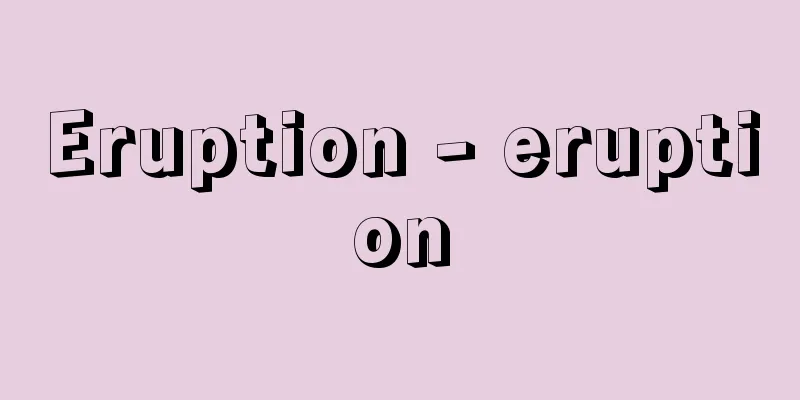Eruption - eruption

|
A phenomenon in which liquid and solid materials such as magma and rocks underground are brought from the crater to the surface (air) through an explosion. When only volcanic gas is released, it is not generally called an eruption. An eruption in which magma itself is mainly ejected is called a magmatic eruption. In a phreatomagmatic explosion, only old lava and pyroclastic material are ejected. Eruptions that are intermediate between the two are sometimes called phreatomagmatic explosions, but the original phreatomagmatic explosions were magma eruptions that occurred on the bottom of the sea or lake. [Setsuya Nakata January 20, 2015] Size and frequency of eruptionsThe scale of an eruption is judged by the amount of ejecta and the height of the column of ash and gas (plume) that rises from the crater. A method of classifying it into nine stages from 0 to 8, called the Volcanic Explosivity Index, has been proposed. Explosivity indices of 8 and 7 are super-eruptions, 6 and 5 are super-eruptions (very large eruptions), 4 is a large-scale eruption, 3 is a moderate-scale eruption, 2 is a medium-scale eruption, 1 is a small-scale eruption, and 0 is a non-explosive eruption. A difference of 1 in the Explosivity Index means a 10-fold difference in the amount of ejecta. In a super-eruption or very large eruption, more than 1 billion cubic meters of ejecta are ejected in a short period of time, and a column of ash rises more than 25 kilometers. In a super-eruption, where a large amount of magma is ejected in a short period of time, a collapsed caldera is usually formed. In a large-scale eruption, the amount of ejecta and the height of the column are more than 100 million cubic meters and more than 10 kilometers, respectively. Medium-sized eruptions are considered to be over 1 million cubic meters and 1 to 5 kilometers long. Small-sized eruptions are considered to be several hundred cubic meters and less than 1 kilometer long. The 1815 eruption of Mt. Tambora on the Indonesian island of Sumbawa was given a Volcanic Explosivity Index of 7, while the 1991 eruption of Mt. Pinatubo on the Philippine island of Luzon was given a Volcanic Explosivity Index of 6. Of Japan's more recent eruptions, the 1707 (4th year of the Hoei era) eruption of Mt. Fuji was given a Volcanic Explosivity Index of 5. The frequency of eruptions is such that small eruptions occur frequently, while large eruptions tend to be rare. For example, there has not been an eruption with an explosion index of greater than 7 since the eruption of Mount Tambora in 1815 (as of 2014). [Setsuya Nakata January 20, 2015] Mechanisms and types of magma eruptionsIn the case of a magmatic eruption, the explosion occurs when the volatile components (mainly water) contained in the magma turn into gas near the surface, separate from the magma (bubbles), and expand in volume. The bubbled magma breaks down into small pieces, and is brought to the ground (air) as volcanic ash, pumice, and volcanic gas. In the case of an explosive eruption, the mixture of volcanic ash and volcanic gas takes in the surrounding air, expands and convects, and rises high, creating a mushroom-cloud-like column of smoke (fume column). The scale of the explosion is determined by how much of the volatile components escape from the magma while it is rising to the ground. Also, the more silicic acid-rich the magma is, the less likely it is for the volatile components to escape, and it is generally more explosive. In the case of a phreatomagmatic explosion, groundwater or seawater comes into contact with the magma, and the heat from the magma heats the water, turning it into steam, causing a sudden increase in pressure, which causes an explosion. At this time, it is thought that the magma breaks into fine powder, and the water evaporates all at once, erupting as fine volcanic ash. During a phreatic explosion, magma does not erupt directly; instead, vaporized water vapor breaks up older rocks and is released as fine volcanic ash. Types of magmatic eruptions include Plinian, Strombolian, Vulcanian, and Hawaiian. In a Plinian eruption, a mushroom-shaped column of smoke made of pumice and volcanic ash is formed, and the pumice and volcanic ash released high into the air are deposited over a wide area. This type of eruption often causes pyroclastic flows to flow down from the crater in all directions. It is seen in large-scale eruptions. It is also called a Plinian eruption. It is named after Pliny the Elder and Junior, who encountered and recorded the eruption that occurred at Mount Vesuvius in Italy in 79 AD. A "Stromboli eruption" is an eruption phenomenon in which splashes and fragments of low-viscosity basaltic magma are periodically ejected in all directions from the crater at relatively short intervals. In long-exposure photographs, it looks like a red shower. It is caused by the bursting of large bubbles in the crater or in the magma directly below it. It is named after the phenomenon that is typically observed at Stromboli volcano in Italy. It is also frequently observed in eruptions at Mount Aso and Suwanosejima in Japan. A "Vulcanian eruption" is an explosive phenomenon often seen in andesitic volcanoes, in which volcanic bombs and cinders are suddenly ejected and smoke of volcanic ash rises. The explosion occurs when lava solidifies in the crater and the pressure of the magma underground increases. The name originates from the Vulcano Volcano in the Lipari Islands in Italy. It is an explosive phenomenon common in Japanese volcanoes such as Mount Asama and Mount Sakurajima. A "Hawaiian-style eruption" is a phenomenon in which low-viscosity, fluid magma erupts from a fissure or multiple craters in a lava fountain, causing the lava to flow over the ground at a relatively high speed. Type sites include Kilauea and Mauna Loa in Hawaii, and they can also be seen on Izu Oshima and Miyakejima. [Setsuya Nakata January 20, 2015] Location of eruption and type of ejectaDepending on where they occur, eruptions may be divided into summit and lateral eruptions, or into central and fissure eruptions, and may also be divided into land, submarine, lake, and subglacial eruptions. The ejecta may take the form of a liquid "lava flow" that flows from the crater and accumulates, or magma or old rocks that have been broken into pieces may be spewed into the sky and accumulate as "pyroclastic debris" (pyroclast fall deposits), or they may flow down the slope together with volcanic gases and accumulate (pyroclastic flow deposits). Secondary deposits include debris avalanche deposits caused by mountain collapses, and mudflow (debris flow) deposits that are transported and accumulated by rainfall or melting snow. [Setsuya Nakata January 20, 2015] Volcanic disasterVolcanic disasters are not directly related to the scale of the eruption, but tend to be exacerbated by the rapid flow of volcanic ash and water over the surface, such as pyroclastic flows, mudflows, and tsunamis caused by submarine eruptions and mountain collapses. In 1902, a pyroclastic flow (heat cloud, volcanic explosivity index 4) occurred at Mt. Pelee, French Martinique, West Indies, killing approximately 28,000 people. In 1985, an eruption (volcanic explosivity index 3) at Mt. Ruiz (Nevado del Ruiz) in Colombia killed approximately 23,000 people due to mudflows. In Japan, Mt. Mayu (Bizan) on the Shimabara Peninsula in Nagasaki Prefecture collapsed immediately after the eruption of Mt. Fugen (Volcanic Explosivity Index 2) in 1792 (Kansei 4), and the tsunami caused by debris avalanches flowing into the Ariake Sea killed approximately 15,000 people. The extent of damage caused by volcanic disasters is largely determined by how close populated areas are to the volcano. [Setsuya Nakata January 20, 2015] "The Mechanism and Prediction of Volcanic Eruptions" by Kubodera Akira (1991, Kokon Shoin)" ▽ "Japan: The Volcanic Archipelago" by NHK reporting team and others (1991, NHK Publishing)" ▽ "Sakurajima - A History of Eruptions and Disasters" by Ishikawa Hideo (1992, Kyoritsu Shuppan)" ▽ "Mountains of Volcanism - The Wonders and Mechanisms of Eruptions" by Robert W. Decker and Barbara B. Decker, translated by Ida Yoshiaki (1995, Nishimura Shoten)" ▽ "Volcanic Eruptions and Disasters" edited by Ui Tadahide (1997, University of Tokyo Press) ▽ "Understanding the Power of Nature - Environmental Restoration in Areas Disaster-hit by Mt. Pinatubo" edited by Yoshida Masao (2002, Kokon Shoin)" ▽ "The Great Eruption of Mt. Asama" by Watanabe Hisashi (2003, Yoshikawa Kobunkan) "Volcanoes: Challenging Eruptions," edited by the Geological Survey of Japan, National Institute of Advanced Industrial Science and Technology (2004, Maruzen)" ▽ "The History of Earthquakes and Eruptions in Japan, by Kazuaki Ito (Iwanami Shinsho)" [References] | | |©Masazumi Fujita "> Schematic diagram of the structure and morphology of a volcano ©Shogakukan "> Type of eruption Source: Shogakukan Encyclopedia Nipponica About Encyclopedia Nipponica Information | Legend |
|
地下にあったマグマ、岩石などの液体や固体が、爆発によって火口から地上(空中)へもたらされる現象。火山ガスのみが放出される場合は一般に噴火とはいわない。おもにマグマそのものが噴出される噴火をマグマ噴火とよぶ。水蒸気爆発では古い溶岩や火山砕屑物(さいせつぶつ)のみが放出される。両者の中間型の噴火のことをマグマ水蒸気爆発とよぶことがあるが、もともとのマグマ水蒸気爆発は海底や湖底で起きたマグマ噴火のことである。 [中田節也 2015年1月20日] 噴火の規模と頻度噴火の規模は、噴出物量や火口から噴き上がる火山灰とガスの噴煙の柱(噴煙柱)高度がその判断の尺度となる。火山爆発指数とよばれ0から8までの9段階に区分する方法が提案されている。爆発指数8や7が超巨大噴火、6と5が巨大噴火(非常に大規模な噴火)、4が大規模噴火、3がやや大規模噴火、2が中規模噴火、1が小規模噴火、0が非爆発的な噴火とされる。爆発指数が1違うと噴出物量は10倍異なる。超巨大噴火、非常に大規模な噴火では10億立方メートル以上の噴出物が短期間に放出され、火山灰の噴煙柱が25キロメートル以上立ち上る。大量のマグマが短期間で放出される超巨大噴火では陥没カルデラができるのが普通である。噴出物量と噴煙柱の高さは、大規模噴火ではそれぞれ1億立方メートル以上で10キロメートル以上。中規模噴火ではそれぞれ100万立方メートル以上で1~5キロメートル。小規模噴火ではそれぞれ数百立方メートルで1キロメートル以下であるとされる。1815年にインドネシアのスンバワ島タンボラ火山でおきた噴火は火山爆発指数が7、1991年フィリピンのルソン島ピナツボ火山でおきた噴火は火山爆発指数が6とされる。日本の比較的新しい噴火では富士山の1707年(宝永4)噴火が火山爆発指数5である。 噴火の頻度は小さな噴火が頻繁におこるのに対し、規模の大きい噴火は少ない傾向にある。たとえば、爆発指数7より大きい噴火はタンボラ火山の1815年噴火以来発生していない(2014年現在)。 [中田節也 2015年1月20日] マグマ噴火の仕組みと種類マグマ噴火の場合は、マグマに含まれている揮発性成分(おもに水分)が地表近くでガスとなってマグマから分離し(泡だって)体積膨張することによって爆発がおこる。泡だったマグマは細かく粉砕し、火山灰、軽石、火山ガスとなって地上(空中)にもたらされる。噴火が爆発的な場合は、火山灰と火山ガスの混合物が周囲の空気を取り込んで膨張・対流しながら高く上昇しキノコ雲状の噴煙の柱(噴煙柱)をつくる。爆発の規模は地上近くまでマグマが上昇してくる間に、マグマから揮発性成分がどれだけ抜けたかによって決まっている。また、ケイ酸分に富むマグマほど揮発性成分が逃げにくく、一般に爆発的になる。マグマ水蒸気爆発の場合は、地下水や海水などがマグマと接触し、マグマの熱で水が加熱され水蒸気化し圧力が急激に高まって爆発がおこる。この際、マグマが細粉化して水の気化が一気におこり、細かい火山灰となって噴出すると考えられている。水蒸気爆発の際は、マグマが直接噴出せず、気化した水蒸気が古い岩石を破砕して、細かい火山灰となって放出される。 マグマ噴火の種類には、プリニー式、ストロンボリ式、ブルカノ式、ハワイ式などがある。 「プリニー式噴火」では軽石や火山灰からなる噴煙の柱がキノコ雲状に形成され、上空高く放出された軽石や火山灰が広範囲に堆積(たいせき)する。この噴火によって火砕流が火口から四方八方に流れ下ることもしばしばある。規模の大きい噴火にみられる。プリニアン噴火ともいう。紀元79年のイタリアのベスビオ火山でおきた噴火現象に遭遇・記録した大小プリニウスの名前に由来する。 「ストロンボリ式噴火」は、火口から粘り気の低い玄武岩質マグマのしぶきや破片が比較的短い間隔で周期的に四方に放出される噴火現象である。長時間露出の写真では赤いシャワーのように見える。火口やその直下にあるマグマ中で大きな泡が破裂することによっておこる。イタリアのストロンボリ火山で特徴的に観察される現象なのでそれに由来する。日本でも阿蘇山(あそさん)や諏訪瀬島(すわのせじま)の噴火でしばしば観測される。 「ブルカノ式噴火」は、安山岩質の火山によくみられる爆発現象で、突然、火山弾や噴石を噴き飛ばし、火山灰の噴煙が上昇する。溶岩が火口でいったん固まって、その地下のマグマの圧力が高まったためにおこる爆発である。イタリアのリパリ諸島ブルカノ火山に由来する。浅間山や桜島など日本の火山で多い爆発現象である。 「ハワイ式噴火」は、粘性の低い流動的なマグマが割れ目火口や複数の火口から溶岩噴泉によって噴出し、溶岩が比較的高速で地上を流れる現象である。ハワイのキラウエアやマウナ・ロアが模式地で、伊豆大島や三宅島(みやけじま)でみられることもある。 [中田節也 2015年1月20日] 噴火の発生場所と噴出物の形態噴火は、発生場所によって山頂噴火と側噴火とに、あるいは、中心噴火と割れ目噴火とに分ける場合もある。さらに、陸上噴火、海底噴火、湖底噴火、氷河下噴火と分けることもある。 噴出物の形態としては、液体状態のままの「溶岩流」が火口から流れてきてたまる場合、および、いったん、粉々になったマグマや古い岩石が「火山砕屑物」として、上空に噴き上げられて降り積もる場合(降下火砕物)と、斜面を火山ガスといっしょに流れてきてたまる場合(火砕流堆積物)とがある。また、二次的な堆積物としては、山体崩壊によっておこる岩屑なだれ堆積物(がんせつなだれさいせつぶつ)や、降雨や雪解け水が媒体となって移動し堆積する泥流(土石流)堆積物がある。 [中田節也 2015年1月20日] 火山災害火山災害は噴火の規模とは直接関係がなく、火砕流、泥流、海底噴火や山体崩壊によって引き起こされた津波など、火山灰や水が急速に地表を流れる現象によって大きくなる傾向がある。西インド諸島のフランス領マルティニーク島プレー火山で1902年におきた火砕流(熱雲、火山爆発指数4)では約2万8000人が犠牲になった。コロンビアのルイス火山(ネバド・デル・ルイス火山)で1985年におこった噴火(火山爆発指数3)では泥流で約2万3000人も犠牲になった。また日本では、長崎県島原(しまばら)半島にある眉山(まゆやま/びざん)が1792年(寛政4)の普賢岳噴火(ふげんだけふんか)(火山爆発指数2)の直後に大崩壊し、岩屑なだれが有明海に流入して引き起こした津波では約1万5000人が犠牲になった。火山災害による被害規模は、人口密集地が火山にどれだけ隣接しているかも大きな要因である。 [中田節也 2015年1月20日] 『久保寺章著『火山噴火のしくみと予知』(1991・古今書院)』▽『NHK取材班他著『火山列島日本』(1991・日本放送出版協会)』▽『石川秀雄著『桜島――噴火と災害の歴史』(1992・共立出版)』▽『ロバート・W・デッカー、バーバラ・B・デッカー著、井田喜明訳『火の山――噴火の驚異とメカニズム』(1995・西村書店)』▽『宇井忠英編『火山噴火と災害』(1997・東京大学出版会)』▽『吉田正夫編『自然力を知る――ピナツボ火山災害地域の環境再生』(2002・古今書院)』▽『渡辺尚志著『浅間山大噴火』(2003・吉川弘文館)』▽『産業技術総合研究所地質調査総合センター編『火山――噴火に挑む』(2004・丸善)』▽『伊藤和明著『地震と噴火の日本史』(岩波新書)』 [参照項目] | | |©藤田正純"> 火山の構造模式図と形態 ©Shogakukan"> 噴火の形式 出典 小学館 日本大百科全書(ニッポニカ)日本大百科全書(ニッポニカ)について 情報 | 凡例 |
Recommend
Kimura Sho-o
...He continues to be the top Edo gyoji to this d...
Zielona Góra
It is the capital of the voyage of the same name i...
Joint Control - Kyodoushihai
A method in which several managers are appointed u...
Gakanji Temple
This temple was built in Changgan, south of the ca...
Patron (English spelling)
Generally it means a patron or protector, but the ...
May Fourth Movement (English spelling)
It refers to the anti-Japanese demonstrations carr...
Yuan Zong-do
…A group of anti-archaicist writers, represented ...
Fukushima [town] - Fukushima
A former town in Kita Matsuura District, northern ...
Tokushima Domain
A clan that held both Awa (Tokushima Prefecture) ...
Bandicoot - Bandicoot (English spelling)
A general term for animals belonging to the order...
English horn (English spelling)
The cor anglais is a transposing instrument in the...
Umar Khayyām
1048‐1131 Iranian poet, astronomy, mathematician, ...
Stercorarius longicaudus (English spelling) Stercorariuslongicaudus
… [Yanagisawa Norio]. … *Some of the terminology ...
Coolant - Reikyakuzai (English spelling)
A liquid or gas used to cool heat-generating machi...
Mold (India) - Mold
...Indian mythology is generally divided into the...









